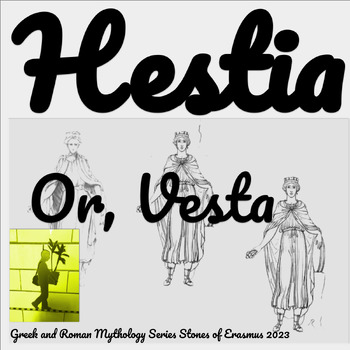In Greek mythology's vast and enthralling realm, two tragic characters stand out, captivating the hearts of students and teachers alike: Narcissus and Echo. These emblematic figures, embodying love, beauty, and vanity, have permeated our culture and language, leaving indelible imprints. To immerse ourselves and our students in their dramatic tale, I have created an educational resource, a comprehensive teaching kit that explores their narrative in engaging and thought-provoking ways.
This resource is not just a static, lifeless document. It is an interactive, vibrant educational tool designed to spark interest and facilitate discussion. With a target audience of middle and high school students, the kit is available as a PDF, Google Slides, and as an Easel Activity and Assessment (exclusive to TpT), offering multiple avenues for engagement.
 |
| Educational Digital Downloads Like This One are Available from Stones of Erasmus. |
Feature-Rich Learning Experience
The resource features a meticulously curated three-day lesson calendar with helpful teacher's notes. An intuitive anchor chart detailing key characters and places provides learners with context and geographical understanding of where these tragic Greek youths lived. A map activity brings this historical context to life, setting the stage for the narratives of Narcissus and Echo.
For the heart of the lesson, there are two-story versions of the Narcissus and Echo myth, each provided with a student-friendly reading protocol. The narratives, followed by a 9-count question bank, aid comprehension and promote discussion. A custom note-taking template ensures students actively engage with the material.
To further enrich the lesson, Frayer Model Vocabulary Cards are included. This innovative technique encourages students to explore vocabulary visually, diving deeper into the terms and contextual entries that fit the story.
Active Understanding and Summative Assessment
The learning process doesn't stop there. Half-sheet exit tickets offer a quick way to gauge student understanding at the end of the lesson. Simultaneously, a writing activity serving as a summative assessment challenges students to write a detailed five-paragraph essay exploring the characters of Echo and Narcissus.
A further reading list, often mistaken as merely a bibliography, provides a wealth of additional resources for those wanting to delve deeper into the myth. Whether for additional assignments or individual exploration, these resources facilitate a more profound understanding and engagement with the tragic tale of Echo and Narcissus.
Teachers will appreciate the included answer keys for all student-facing documents. These keys guide students on what to expect in their written and oral responses.
Integrating the Old with the New
This resource, created with high school students in mind, is an excellent addition to any English Language Arts Mythology unit. It encourages students to discuss beauty, vanity, unrequited love, anthropomorphic personification, and more.
Moreover, this resource can easily be paired with a larger unit on Ovid's Metamorphoses, Percy Jackson and the Lightning Thief, Robert Graves's Greek Myths, or Edith Hamilton's Mythology. It supplements a unit on Graeco-Roman Mythology, offering links to full-text primary resources online.
To explore more myths and legends, check out similar resources on the stories of Cupid and Psyche, Zeus and Metis & The Birth of Athena, Apollo and Daphne, and many more lessons included in the Middle and High School Mythology Series.
A Gift of Knowledge
Lastly, I'd like to thank the New York Public Library Digital Collections. They have made a wealth of public domain material available to the public, a generous gift to educators and learners alike.
Discover a new world of ancient tales with this resource, and join me on a journey through the enthralling stories that have shaped human culture and thought. Embark on the path of knowledge at Stones of Erasmus, © 2023 stonesoferasmus.com.

.png)








